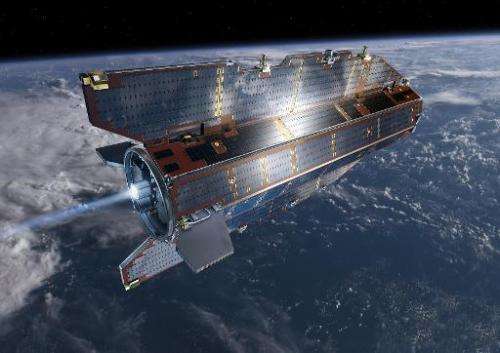Satellite's gravity-mapping mission is over, ESA says

A satellite measuring Earth's gravity since 2009 ran out of fuel Monday and will reenter the atmosphere within three weeks, when it will mostly disintegrate, the European Space Agency said.
Experts have said there will be little risk to humans when about 40 to 50 surviving fragments of the Gravity Ocean Circulation Explorer (GOCE) satellite hit our planet, though where and when this will happen is not yet known.
"The GOCE satellite has run out of fuel and the end of mission has been declared," said an ESA statement.
The one-tonne satellite's stock of 41 kilograms (90 pounds) of fuel finally ran out at about 0320 GMT, GOCE mission manager Rune Floberghagen told AFP.
"We think it will take no less than two weeks, and no more than three weeks" for the satellite to reenter Earth's atmosphere.
GOCE was launched into orbit in March 2009 at an altitude of 260 kilometres (160 miles)—later lowered to 224 km—the lowest ever for a research satellite.
The 350-million-euro ($465-million) mission has lasted twice as long as its initially-scheduled 20 months.
Having now run out of fuel to keep it in orbit, the satellite will lose altitude and become unstable.
Its main gravity-mapping instrument has stopped working, but other gauges will continue gathering data for about two more weeks, according to Floberghagen.
Most of the 5.3-metre-long (17.2-foot) spacecraft will break up at an altitude of about 80 kilometres (50 miles), ESA spacecraft operations manager Christoph Steiger said last week.
But about a quarter of its mass, some 250 kilogrammes (550 pounds), will survive—hitting the Earths' surface in a trail of fragments over an area of a few hundred kilometres. Whether this will be on land or sea is not yet known.
"A few hours before, we will be able to tell with... a few thousand kilometres of precision" where the fragments are likely to impact, said Steiger—insisting the chances of a human being hit were about 65,000 times lower than getting struck by lightning.
In 50 years of spaceflight, there have been no casualties from manmade space debris, despite about 20-40 tonnes impacting somewhere on Earth each year, said Steiger.
Scientists say GOCE has returned the most accurate data yet on Earth's gravity field and ocean circulation.
It was designed and built before 2008, when international recommendations were adopted that a scientific satellite must be able to execute a controlled reentry, or burn up completely after its mission.
Steiger said a global space debris coordinating committee was monitoring the satellite to predict its point of reentry, "and we are passing on the information to national authorities.
© 2013 AFP





















